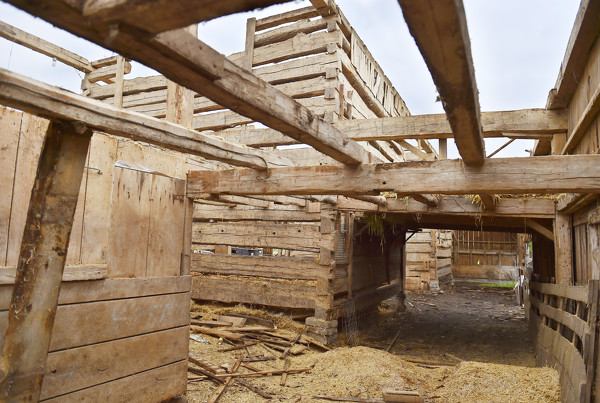
Local historian Mary Ann Olding said this barn near Minster that was razed was rare. Built in the late 1800s, it was a double-pen log barn, an uncommon find in Ohio, according to Olding.
MINSTER - A local historian hopes the loss of a rare barn in Auglaize County that was built in the late 1800s will spur interest in preserving the historic structures.
"This was an exceedingly rare find," said Mary Ann Olding, a local historian who has studied the area's architecture.
The barn, located at 1923 State Route 119 and owned by Gary and Joanna Homan, was a double-pen log barn. Not only were double-pen barns uncommon in Ohio, but they also required twice the labor, materials and cost to build, making them a considerable undertaking, she said.
"Double-pen barns were twice the work and price," Olding said in an interview Tuesday. "A double-pen barn is very, very rare. You won't often see a double-pen barn."
In early July, the Daily Standard received a call from a resident who said his neighbor was tearing down a large barn that looked like it had a log cabin inside of it. The Daily Standard was able to capture a handful of photos of the barn before it was razed.
Olding said the Homans were unable to manage the upkeep of the large, more than 100-year-old barn, and it was unusable for housing modern farm equipment or livestock.
The substructure inside the barn was the double-pen barn, the first structure to be built, and the outer structure was built later, which is what gave the appearance of a log cabin inside a barn, Olding said.
Single-pen log barns were common in the early settlement days, although they were not the most common type of barns built in the area during this time period, Olding said.
Single- and double-pen barns were used for sheltering livestock, grain storage and equipment housing, Olding said. The barns were most often built of logs laid horizontally and held together by notched corners, as there were no lumber mills at the time, she said. The barns may or may not have included a hay loft depending on the specific barn.

Local historian Mary Ann Olding said this barn near Minster that was razed was rare. Built in the late 1800s, it was a double-pen log barn, an uncommon find in Ohio, according to Olding.
Double-pen barns consisted of two pens separated by a breezeway that were covered by the same roof, Olding said. The breezeway essentially acted as a driveway leading into the barn and could be used for farming equipment or threshing grain, she said.
Most barns in Ohio, including this double-pen barn, were multi-functional, Olding said. Some structures served as housing for both animals and people, she said. Animals would stay in one pen on the opposite side of the structure, while a family would live on the other side. The animals served as a way of adding extra heat inside the building, she said.
"People had a different view of barns," Olding said of early settlers. "Barns were essential."
Olding said all log barns in Mercer and Auglaize counties are representative of the settlement period in the early- to mid-1800s. The southern portion of Mercer County was settled largely by Germans from the northwest portion of Germany, she said.
"Once the (Miami-Erie) Canal was made, Germans flooded the area," Olding said. "They could buy land from the government for cheap, and it had good farmland. This was no picnic, what (pioneers) did to settle this area."
John Henry Schulte, the first owner of the property, acquired 40 acres from the U.S. government on Oct. 16, 1835, and deeded it to his son, Henry Schulte, on Dec. 12, 1874, according to information provided by Olding. She said the information came from the records of Marvin Schulte, a neighbor of the Homan's and genealogist who died in 2019.
The property stayed in the Schulte family until May 4, 1916, when it was sold to Henry Baumer, according to Marvin Schulte's records. Eventually, Nicholas Baumer sold the property to the Homans on March 12, 2012, according to the Auglaize County Auditor's office.
Interestingly, Olding said Marvin Schulte's records indicate both Gary and Joanna Homan are distantly related to previous owners of the farm.
While the barn may be gone, Olding said she hopes people take an interest in the historic structures and try to preserve them.
The Friends of Ohio Barns offers a Barn Conservancy Grant, in which grants of $2,500 will be awarded to Ohio organizations, communities or individual barn owners willing to open their barns for public educational purposes.
Derived from the Friends of Ohio Barns Endowment, funds may be used to aid in barn preservation and stewardship efforts.
There are also 20% and 10% federal rehabilitation tax credits available for the rehabilitation of historic barns, according to the Ohio History Connection.
Buildings have to be certified as a historic structure by the National Park Service, and the barn would need to be used for either agricultural purposes or some other business, according to the NPS.
Individuals interested in applying for the 20% tax credit can contact the State Historic Preservation Office at 614-298-2000 for more detailed information. For advice on the 10% credit, the Ohio History Connection suggests asking a tax accountant.
The Ohio History Connection also has a packet of practical information and advice for barn owners, which can be obtained by contacting the State Historic Preservation Office at 614-298-2000.
For more information on historic barn preservation in Ohio, visit the Ohio History Connection at www.ohiohistory.org or Friends of Ohio Barns at www.friendsofohiobarns.org.